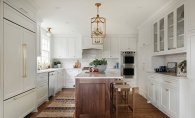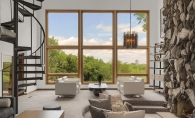There’s no need to remain glued to tired wallpaper styles. Taking a cue from other elements in today’s style world, wallcoverings have gone bold, metallic, interactive and personalized in the quest to make an updated décor statement.
Wallpaper has transcended that 1980s and ’90s vibe. Matchy-matchy borders are no longer en vogue, and ivy-blanketed dining walls have been replaced with large-scale palm leaves. Wall coverings are also providing pathways to emulate other textural décor trends, allowing for board without the batten and brick without the mortar.
“I feel there is so much more available,” says Talla Skogmo of Talla Skogmo Interior Design.
“We are seeing a lot of pastels,” Skogmo says. “But bold, clear colors are always good.” Aqua, jade and coral tones are popular at Hirshfield’s, notes decor consultant Michelle Picha. “Metallic has a big influence on paper,” she adds, explaining that tone-on-tone paper with shimmers offer a special effect. “It makes it more like jewelry for the wall,” she says. Picha also says large, oversize florals are making a statement.
Textured wallcovering is having more than a passing moment. “We are doing a lot of linen textures and paper-backed fabric, along with beautiful grass cloths,” Skogmo says. She recommends vinyl-textured wall coverings as a great substitute for paint.
“We just completed a project that is very traditional,” Skogmo says. “We used a beautiful grass cloth in the dining room, a custom hand-screened paper in the powder room, a quilted damask wallcovering in the master dressing area and a beautiful linen with bronze studs in a bath on the walls and ceiling.”
Don’t ignore the ceiling. “It’s your fifth wall and allows you to have fun with it,” Picha says.
She recommends random and nonsymmetrical patterns. Using wallpaper, customers have created faux tin and beadboard ceilings; another used a shimmering paper, making the room resemble a jewelry box.
Other trends include large decals of a single image and wallpaper that acts as a whiteboard or chalkboard. “We have used a lot of magnetic wallcovering. Clients love it, but it can be very expensive,” Skogmo says.
Finding new ways to utilize wallpaper is also part of the fun. Clients, says Picha, are running striped paper horizontally, rather than the traditional vertical, as a way to open up a room’s space and create a modern turn on stripes.
What doesn’t feel as popular is border paper, which wrapped itself through the 1980s and ’90s around miles of ceilings and chair rails. Fewer companies include it in their sample books, and Skogmo doesn’t use it much anymore.
Given some creativity, most areas, including accent walls and niches, should be game for wallpaper. “Any space is good, but bathrooms seem to be the best, because you spend little time in them, and you will not tire of the paper,” Skogmo says.
Most importantly, “Always use a professional, and most wallcovering [brands] will recommend if a special paste is to be used.”
Not all of today’s wallpaper requires paste. Hirshfield’s carries NuWallpaper, a peel-and-stick collection, which is much easier to apply and remove than traditional wallcoverings are. Deb Camp, decor consultant, says there were several requests for the product, which has been in the Edina store since late winter. Camp says it’s mostly used for smaller areas and for nontraditional spaces, including on dresser faces and stair risers.
There’s no need to remain glued to tired wallpaper styles. Taking a cue from other elements in today’s style world, wallcoverings have gone bold, metallic, interactive and personalized in the quest to make an updated décor statement.
Wallpaper has transcended that 1980s and ’90s vibe. Matchy-matchy borders are no longer en vogue, and ivy-blanketed dining walls have been replaced with large-scale palm leaves. Wall coverings are also providing pathways to emulate other textural décor trends, allowing for board without the batten and brick without the mortar.
“I feel there is so much more available,” says Talla Skogmo of Talla Skogmo Interior Design.
“We are seeing a lot of pastels,” Skogmo says. “But bold, clear colors are always good.” Aqua, jade and coral tones are popular at Hirshfield’s, notes decor consultant Michelle Picha. “Metallic has a big influence on paper,” she adds, explaining that tone-on-tone paper with shimmers offer a special effect. “It makes it more like jewelry for the wall,” she says. Picha also says large, oversize florals are making a statement.
Textured wallcovering is having more than a passing moment. “We are doing a lot of linen textures and paper-backed fabric, along with beautiful grass cloths,” Skogmo says. She recommends vinyl-textured wall coverings as a great substitute for paint.
“We just completed a project that is very traditional,” Skogmo says. “We used a beautiful grass cloth in the dining room, a custom hand-screened paper in the powder room, a quilted damask wallcovering in the master dressing area and a beautiful linen with bronze studs in a bath on the walls and ceiling.”
Don’t ignore the ceiling. “It’s your fifth wall and allows you to have fun with it,” Picha says.
She recommends random and nonsymmetrical patterns. Using wallpaper, customers have created faux tin and beadboard ceilings; another used a shimmering paper, making the room resemble a jewelry box.
Other trends include large decals of a single image and wallpaper that acts as a whiteboard or chalkboard. “We have used a lot of magnetic wallcovering. Clients love it, but it can be very expensive,” Skogmo says.
Finding new ways to utilize wallpaper is also part of the fun. Clients, says Picha, are running striped paper horizontally, rather than the traditional vertical, as a way to open up a room’s space and create a modern turn on stripes.
What doesn’t feel as popular is border paper, which wrapped itself through the 1980s and ’90s around miles of ceilings and chair rails. Fewer companies include it in their sample books, and Skogmo doesn’t use it much anymore.
Given some creativity, most areas, including accent walls and niches, should be game for wallpaper. “Any space is good, but bathrooms seem to be the best, because you spend little time in them, and you will not tire of the paper,” Skogmo says.
Most importantly, “Always use a professional, and most wallcovering [brands] will recommend if a special paste is to be used.”
Not all of today’s wallpaper requires paste. Hirshfield’s carries NuWallpaper, a peel-and-stick collection, which is much easier to apply and remove than traditional wallcoverings are. Deb Camp, decor consultant, says there were several requests for the product, which has been in the Edina store since late winter. Camp says it’s mostly used for smaller areas and for nontraditional spaces, including on dresser faces and stair risers.










